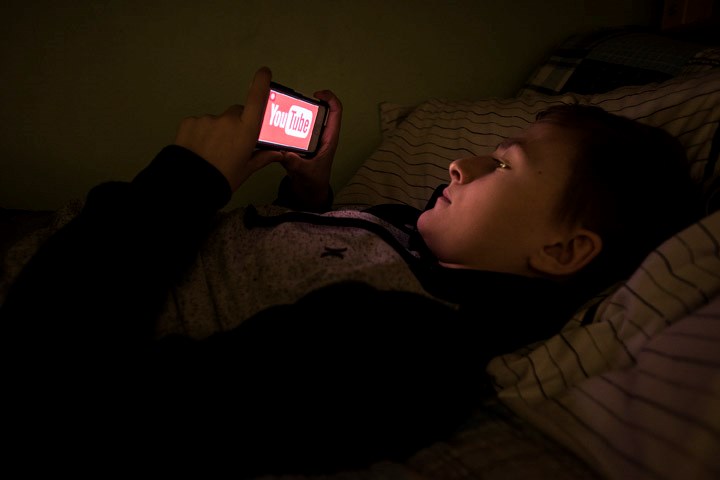YouTube Kids, a channel that teaches children numbers, colours and other foundational skills, could actually be a wolf in sheep’s clothing.
St. Albert parents are being warned to think twice before leaving their children alone on the video-sharing website after videos have emerged with disturbing content.
Children who looked up content familiar to them were exposed to videos that left them upset, such as Peppa Pig being eaten by a dinosaur or taking a traumatizing trip to the dentist.
Andrea Thrall, registered psychologist with Rivers Edge Counselling Centre, said parents should always be present whenever young children are viewing videos.
“That way parents can always be monitoring what their children are viewing and take quick steps to prevent their kids from seeing inappropriate materials,” she said.
YouTube usually blocks inappropriate videos by following algorithms that track key words input by a content creator when they upload a video, but the content was so similar to actual child-friendly videos that they managed to slip past YouTube’s system.
The company has 400 hours of video uploaded to the site each minute, which could be a reason some videos get past its filtering system. According to Business Insider, the company maintains that less than .005% of the millions of videos viewed on YouTube Kids in the past 30 days had inappropriate content.
Thrall said even though it's easy to send their children away with a device to keep them occupied, it's not the best solution.
“We can put pressure on these organizations to filter their material, but at the end of the day, that’s our job as parents,” she said. “We can ask for a safe environment online, but that doesn’t take away our responsibility as parents to be monitoring what our children are accessing.”
Common Sense Media, a website that reviews content in movies, games, apps, TV shows, websites, books and music for parents, released a study on how many hours children spent viewing media.
The study surveyed 1,454 parents of children age 8 or under and took place from Jan. 20, 2017, to Feb. 10, 2017.
It found that while time spent watching media is relatively similar to years prior, how U.S. children view it has vastly changed.
While television is still the primary mode children view media, watching it on mobile devices increased by 29 per cent compared to 2011 when only four per cent of children viewed content on a mobile device.
The survey also found that around 42 per cent of U.S. children own their own tablet.
Not only has YouTube Kids come under fire for its videos, in recent weeks a popular YouTube star has also come into the limelight for sharing disturbing content.
Logan Paul, who has a following of 15.6 million YouTube subscribers largely comprised of teenagers, uploaded a video from an excursion in Japan’s ‘suicide forest’. The forest – Aokigahara or also known as the Sea of Trees – is located at the northwestern part of Mount Fuji. It has gained popularity throughout the world for the number of suicides that have occurred in the forest, as has been reported on in the New York Times.
While filming, Paul and a group of friends stumbled upon an individual who had hanged himself.
In the video Paul, 22, is shown laughing nervously and making a few jokes next to the body. Even though the face was blurred, the video repeatedly zoomed in on the body while Paul stood next to it.
The video reached around six million views before Paul took it down. During that time he received widespread backlash for it, which lead to questions on why YouTube allowed the video to be uploaded in the first place.
Thrall said it’s this type of content that parents should be on the lookout for. While viewing violent content a single time won’t likely have a lasting impact, repeated exposure could have some psychological repercussions.
Thrall said people repeatedly exposed to violent or sexual content could act out aggressively or be over sexualized in the world around them.
What parents can do
While it can be more difficult to monitor the online activity of teenagers, she said engaging in open communication is key.
“As kids get older, they’re going to get a little bit more independent with their access to technology,” she said. “So it’s important to encourage kids to be open about what sites they’re visiting.”
Thrall recommends putting a computer in a family-shared room instead of a young person's bedroom, and frequently asking their child to show them what they watch online to reduce the chances of exposure to inappropriate content.
She also said it’s important not to get mad when their child admits to seeing something they shouldn’t have. Instead, the parent can build a trusting relationship if they talk about what their child has seen in a way that’s educational and supportive.
Thrall said when young people view something disturbing, such as a body hanging from a tree, they may not have the emotional maturity to process what they’ve seen.
“That’s going to raise feelings of alarm and feelings of anxiety, because they weren’t prepared for that,” she said. “When kids do encounter that, they need adult support to make sense of it, to understand it, to put it in context.”
There are other ways that children can access educational videos, such as CBC Kids and Treehouse TV, if parents are weary about viewing videos on YouTube.




